INSTITUT SUPERIEUR D'ANTHROPOLOGIE
INSTITUTE OF ANTHROPOLOGY
ONLINE COURSES / COURS A DISTANCE
SUMMER TERM : JULY 2013
REGISTER NOW
GRECE – 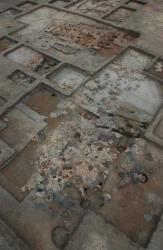 Avgi - Tracing households, people and meanings: ten years of research activity at the Neolithic settlement of Avgi, Kastoria, NW Greece. In the mid-sixth millennium BC, a new farming community was established within the social Neolithic environment of the Kastoria region, at a short distance from the modern village of Avgi, and about 10 km SW of Lake Orestida. The Neolithic settlement, that covers an area of 55-60 acres, was situated on an extended terrace with an average altitude of 740 m, in a hilly landscape with a dynamic network of rivers and streams, an abundance of clay materials, and rich vegetation made up of oak forests and riparian plant formations. Recent excavations (2002-2008) have revealed three distinct phases of occupation (Avgi I, II and III) dated to the Middle and mostly to the Late Neolithic period. Throughout the period that Neolithic Avgi was inhabited, which lasted approximately 1000 years, interesting changes occurred in the spatial organization of the site, building technology and material culture, as well as the social-symbolic practices. Phase Avgi I (second half of the sixth millennium BC) is characterized by the presence of free-standing buildings which were intentionally destroyed by fire at the end of their life-cycles, and large highly interactive open areas (‘yards’). During phase Avgi II (early fifth millennium BC), the residential area shifted and reorganized; the habitation traces comprise mostly of outdoor activity areas, as well as a burial area with cremations, ascribing a strong symbolic meaning to the site. The latest documented phase Avgi III (first half of the fifth millennium BC) introduces new forms in the organization of built space, new construction elements and building layouts. Some buildings are defined by the presence of ditches, while the whole habitation area is now enclosed by a system of ditches. Moreover, there is evidence for the structured deposition of materials in a series of small and larger pits within the settlement.
Avgi - Tracing households, people and meanings: ten years of research activity at the Neolithic settlement of Avgi, Kastoria, NW Greece. In the mid-sixth millennium BC, a new farming community was established within the social Neolithic environment of the Kastoria region, at a short distance from the modern village of Avgi, and about 10 km SW of Lake Orestida. The Neolithic settlement, that covers an area of 55-60 acres, was situated on an extended terrace with an average altitude of 740 m, in a hilly landscape with a dynamic network of rivers and streams, an abundance of clay materials, and rich vegetation made up of oak forests and riparian plant formations. Recent excavations (2002-2008) have revealed three distinct phases of occupation (Avgi I, II and III) dated to the Middle and mostly to the Late Neolithic period. Throughout the period that Neolithic Avgi was inhabited, which lasted approximately 1000 years, interesting changes occurred in the spatial organization of the site, building technology and material culture, as well as the social-symbolic practices. Phase Avgi I (second half of the sixth millennium BC) is characterized by the presence of free-standing buildings which were intentionally destroyed by fire at the end of their life-cycles, and large highly interactive open areas (‘yards’). During phase Avgi II (early fifth millennium BC), the residential area shifted and reorganized; the habitation traces comprise mostly of outdoor activity areas, as well as a burial area with cremations, ascribing a strong symbolic meaning to the site. The latest documented phase Avgi III (first half of the fifth millennium BC) introduces new forms in the organization of built space, new construction elements and building layouts. Some buildings are defined by the presence of ditches, while the whole habitation area is now enclosed by a system of ditches. Moreover, there is evidence for the structured deposition of materials in a series of small and larger pits within the settlement.
http://www.archaiologia.gr/en/blog/2013/05/15/%CF%84en-years-of-research-activity-at-the-neolithic-settlement-of-avgi-kastoria/
ROYAUME UNI – 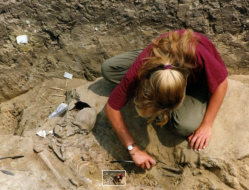 Stonea Camp hill fort - The site, near Wimblington, was the scene of some of the most important events surrounding the Iceni tribe and Romans in Fenland. Stephen Macaulay, senior project manager at Oxford Archaeology East said: “Stonea Camp is a wonderful site and one of the most important archaeological sites in East Anglia, if not Britain itself. “Indeed it is perhaps the first site in the whole of Britain which enters the historical, as well as archaeological record and people should take this opportunity to discover its secrets.” The fort formed part of the frontier of the Iceni tribe of Norfolk, who twice rose in revolt against the Roman invaders.
Stonea Camp hill fort - The site, near Wimblington, was the scene of some of the most important events surrounding the Iceni tribe and Romans in Fenland. Stephen Macaulay, senior project manager at Oxford Archaeology East said: “Stonea Camp is a wonderful site and one of the most important archaeological sites in East Anglia, if not Britain itself. “Indeed it is perhaps the first site in the whole of Britain which enters the historical, as well as archaeological record and people should take this opportunity to discover its secrets.” The fort formed part of the frontier of the Iceni tribe of Norfolk, who twice rose in revolt against the Roman invaders.
http://www.cambstimes.co.uk/news/archaeologist_will_uncover_stonea_camp_s_secrets_at_special_event_1_2195198
ROYAUME UNI – 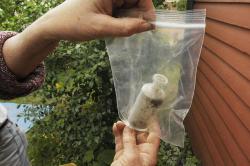 Windsor - Volunteer archaeologists sift through the earth at an archaeology dig at the Strong-Howard house in Windsor Tuesday afternoon. They found a button, bones, bottles, smoking pipes and a musket ball beneath the floor of an addition of the home. The house is under restoration. The floor of one of the additions had been pulled up, offering an opportunity for the Windsor Historical Society to find out what treasures lay in the soil under the floor boards. The two bottles that were found are thought to be from around 1850. The original house was built around 1758 by Windsor merchant John Strong. Nathaniel Howard, a West Indies trader who married into a wealthy East Windsor family, had the home from 1772 to 1837, according to the historical society.
Windsor - Volunteer archaeologists sift through the earth at an archaeology dig at the Strong-Howard house in Windsor Tuesday afternoon. They found a button, bones, bottles, smoking pipes and a musket ball beneath the floor of an addition of the home. The house is under restoration. The floor of one of the additions had been pulled up, offering an opportunity for the Windsor Historical Society to find out what treasures lay in the soil under the floor boards. The two bottles that were found are thought to be from around 1850. The original house was built around 1758 by Windsor merchant John Strong. Nathaniel Howard, a West Indies trader who married into a wealthy East Windsor family, had the home from 1772 to 1837, according to the historical society.
http://www.courant.com/community/windsor/hc-pictures-windsor-archaeology-dig-20130514,0,5482024.photogallery
FRANCE –  Thouars - Des restes d'occupation d'il y a 7.000 ans ont été mis au jour par les chercheurs de l'Institut national de recherches archéologiques préventives (Inrap), à l'endroit où seront implantés les cottages et les infrastructures du futur Center Parcs, près des Trois-Moutiers. 80 ha seront passés au peigne fin avant le début des constructions. Sur le terrain, Vincent Lhomme, responsable régional de l'Inrap, et Guillaume Pouponnot, adjoint de l'Inrap, expliquent avoir découvert « les trous de poteaux d'une construction gallo-romaine. Des éléments de poteries alentour ont confirmé cette hypothèse. » Une importante occupation du site a été mise au jour, du néolithique à l'époque gallo-romaine. Une meule et son broyon, une herminette et une hache-marteau témoignent d'une activité humaine du néolithique (de 4.500 à 2.200 ans avant notre ère). C'est la période où ont été édifiés les dolmens, que l'on trouve à proximité (Fontaine de Son, Vaon, la Roche-Vernaize, etc.). Pour Marlène Mazière, « cette mission est une opportunité pour la recherche archéologique sur ce secteur, qui n'avait jamais été prospecté. »
Thouars - Des restes d'occupation d'il y a 7.000 ans ont été mis au jour par les chercheurs de l'Institut national de recherches archéologiques préventives (Inrap), à l'endroit où seront implantés les cottages et les infrastructures du futur Center Parcs, près des Trois-Moutiers. 80 ha seront passés au peigne fin avant le début des constructions. Sur le terrain, Vincent Lhomme, responsable régional de l'Inrap, et Guillaume Pouponnot, adjoint de l'Inrap, expliquent avoir découvert « les trous de poteaux d'une construction gallo-romaine. Des éléments de poteries alentour ont confirmé cette hypothèse. » Une importante occupation du site a été mise au jour, du néolithique à l'époque gallo-romaine. Une meule et son broyon, une herminette et une hache-marteau témoignent d'une activité humaine du néolithique (de 4.500 à 2.200 ans avant notre ère). C'est la période où ont été édifiés les dolmens, que l'on trouve à proximité (Fontaine de Son, Vaon, la Roche-Vernaize, etc.). Pour Marlène Mazière, « cette mission est une opportunité pour la recherche archéologique sur ce secteur, qui n'avait jamais été prospecté. »
http://www.lanouvellerepublique.fr/Toute-zone/Loisirs/Patrimoine-tourisme/n/Contenus/Articles/2013/05/15/Vestiges-neolithiques-sous-le-futur-Center-Parcs-1466135
FRANCE – Bourguébus - L'Institut national de recherches archéologiques préventives (Inrap) a découvert une place forte de l'époque gauloise à l'endroit d'un futur lotissement de la commune de Bourguébus. Ces fouilles doivent s'achever ce mois-ci et les pièces importantes seront étudiées et conservées dans un musée.
http://www.tendanceouest.com/caen/depeche-54271-un-place-forte-gauloise-decouverte-a-bourguebus-.html
ROYAUME UNI – Ilkley - A dig by archaeologists on the site of Ilkley’s Roman fort has cleared the path for church redevelopment plans – and revealed more of the town’s history. a report by contractor Archaeological Services WYAS has revealed late-Roman era pottery was found in the dig, suggesting the site was occupied in the final stages of the Roman period. Finds included a fragment from a jar from around the 1st century AD, pieces of greyware bowls and jars from the Antonine occupation of the site, and pottery sherds including a piece of a Huntcliff jar, dating to the 4th or 5th century and probably brought to the site from the Vale of Pickering. A previous dig in the 1960s did not find any evidence of this type of pottery, say the archaeologists. Archaeologists also believe further groundworks may reveal the positions of graves, and possible human remains. Other small finds discovered in the dig included pieces of medieval and post-medieval pottery, pieces of post-1750 clay tobacco pipes, iron nails, a fragment of an 18th-century wine bottle, animal bone and an oyster shell.
http://www.wharfedaleobserver.co.uk/news/10417767.Archaeological_dig_reveals_secrets_of_Ilkley_s_history/?ref=rss
FRANCE – 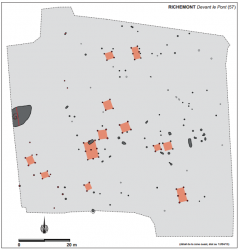
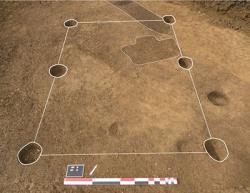 Richemont - A la suite d’un diagnostic archéologique qui s’est révélé positif, le site de la carrière d’extraction de matériaux de Richemont (57), au lieu-dit Devant le pont, a fait l’objet d’une prescription archéologique sur plusieurs hectares. Les opérations de fouille s’échelonneront en plusieurs tranches dont la première a été effectuée durant l’été 2011. En mars 2013 ont débuté les travaux de la seconde tranche, s’étendant sur près de 2 ha. La fouille est encore en cours mais différentes phases ont déjà pu être observées. L’occupation la plus importante est datée du premier âge du fer. Elle est matérialisée sur le terrain par la présence d’un grand nombre trous de poteau appartenant à des structures de stockage de type « grenier surélevé » (à 4, 6 ou 9 TP). Au 5 mai, un total de 41 bâtiments a déjà pu être identifié. Par ailleurs quelques fosses ont livré du mobilier néolithique en surface. Celles-ci, localisées en marge du terrain décapé, n’ont pas encore été traitée. Enfin, un ensemble de fosses alignées comportant une ou plusieurs zones de foyer peuvent être mentionnés. Le mobilier recueilli indique une datation moderne (XVIIIe siècle). Ces structures sont peut-être liées a d’importantes manœuvres militaires qui ont eu lieu dans le secteur en septembre 1755 ou peut-être encore au siège de Thionville, daté de 1792, au cours duquel un camp militaire prussien et autrichien était établi sur la commune de Richemont.
Richemont - A la suite d’un diagnostic archéologique qui s’est révélé positif, le site de la carrière d’extraction de matériaux de Richemont (57), au lieu-dit Devant le pont, a fait l’objet d’une prescription archéologique sur plusieurs hectares. Les opérations de fouille s’échelonneront en plusieurs tranches dont la première a été effectuée durant l’été 2011. En mars 2013 ont débuté les travaux de la seconde tranche, s’étendant sur près de 2 ha. La fouille est encore en cours mais différentes phases ont déjà pu être observées. L’occupation la plus importante est datée du premier âge du fer. Elle est matérialisée sur le terrain par la présence d’un grand nombre trous de poteau appartenant à des structures de stockage de type « grenier surélevé » (à 4, 6 ou 9 TP). Au 5 mai, un total de 41 bâtiments a déjà pu être identifié. Par ailleurs quelques fosses ont livré du mobilier néolithique en surface. Celles-ci, localisées en marge du terrain décapé, n’ont pas encore été traitée. Enfin, un ensemble de fosses alignées comportant une ou plusieurs zones de foyer peuvent être mentionnés. Le mobilier recueilli indique une datation moderne (XVIIIe siècle). Ces structures sont peut-être liées a d’importantes manœuvres militaires qui ont eu lieu dans le secteur en septembre 1755 ou peut-être encore au siège de Thionville, daté de 1792, au cours duquel un camp militaire prussien et autrichien était établi sur la commune de Richemont.
http://www.antea-archeologie.com/news/6/92/Un-site-du-premier-age-du-Fer-a-Richemont.html